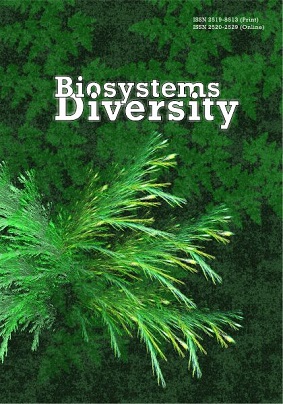Influence of multicomponent contamination on the content of photosynthetic pigments in the leaves of woody plants commonly planted for greening of cities
Influence of multicomponent contamination on the content of photosynthetic pigments in the leaves of woody plants commonly planted for greening of cities
Author(s): V. P. Bessonova, A. S. Chongova, A.V. SklyarenkoSubject(s): Agriculture, Energy and Environmental Studies, Human Ecology, Rural and urban sociology, Environmental interactions
Published by: Дніпропетровський національний університет імені Олеся Гончара
Keywords: technogenic conditions; trees; leaf plates; chlorophyll; carotenoids;
Summary/Abstract: Woody plants, as an important element of optimization of the urban environment, respond negatively to the ever-increasing technogenic pressure in cities. Therefore, it is necessary to assess their vital status, the most sensitive indicator of which being the content of plastid pigments.In this article we analyze the effects of multicomponent contamination on quantitative fluctuation of the level of photosynthetic pigments in the leaves of woody plants and identify sensitive species for the purpose of phytoindication in order to assess the state the environment is currently in. For the purposes of our research we chose the most widespread tree species in the city of Dnipro (Steppe zone of Ukraine), growing in the area of intensive industrial pollution and high levels of emissions by vehicles. We determined the content of photosynthetic pigments (chlorophylls a and b, a + b, carotenoids) in the leaves of woody plants during different months of the growing season (June, July, August) and afterwards this data was used to compare the given parameters against the values taken from trees in the control area. The sum of chlorophyll levels a + b for the majority of plants was decreasing compared to the control. A more significant decrease in the content given by the sum of the a and b chlorophyll levels is observed in the assimilation organs of Aesculus hippocastanum L., Pinus pallasiana (D. Don) and Picea abies(L.) H. The most significant changes in the content of pigments in the leaves of plants under study were detected at the end of the growing season (in August). The content of green pigments in the leaves of Robinia pseudoacacia L., Platanus orientalis L. remains virtually unchanged. Under the influence of multicomponent contamination, the amount of pigments in the case of chlorophyll a in the majority of woody plant species decreases more rapidly compared to the control than in the case of chlorophyll b. The most noticeable drop in the content of chlorophyll a occurs in the leaves of Betula pendulaRoth, Ae. hippocastanum, P. pallasiana, Acer platanoidesL. and Tilia cordata Mill. The needles of P. abies and Picea pungens Engelm. 'Glauca’ on the contrary suffer from a significant reduction in the concentration of chlorophyll b. The species most resistant to multicomponent contamination in terms of changes in the content of chlorophyll in the leaf blade are R. pseudoacacia, P. orientalis. The concentration of carotenoids in the leaves of plants such as B. pendula, Ae. hippocastanum, A. platanoides, T. cordata, P. abies is lower than that of species growing in the relatively clean zone. The concentration of pigments in Populus alba L., P. pungens 'Glauca’ was higher during all of the months elapsed since the beginning of our study, whereas Ulmus laevis Pall., P. orientalis and R. pseudoacacia – had their concentrations reach an all time high in the second half of the growing season. Therefore, the peculiarities of quantitative fluctuation of photosynthetic pigments in plants, which are characterized by the variable resistance ability against the effects of technogenic multicomponent contamination, have been identified.
Journal: Biosystems Diversity
- Issue Year: 28/2020
- Issue No: 2
- Page Range: 203-208
- Page Count: 6
- Language: English

